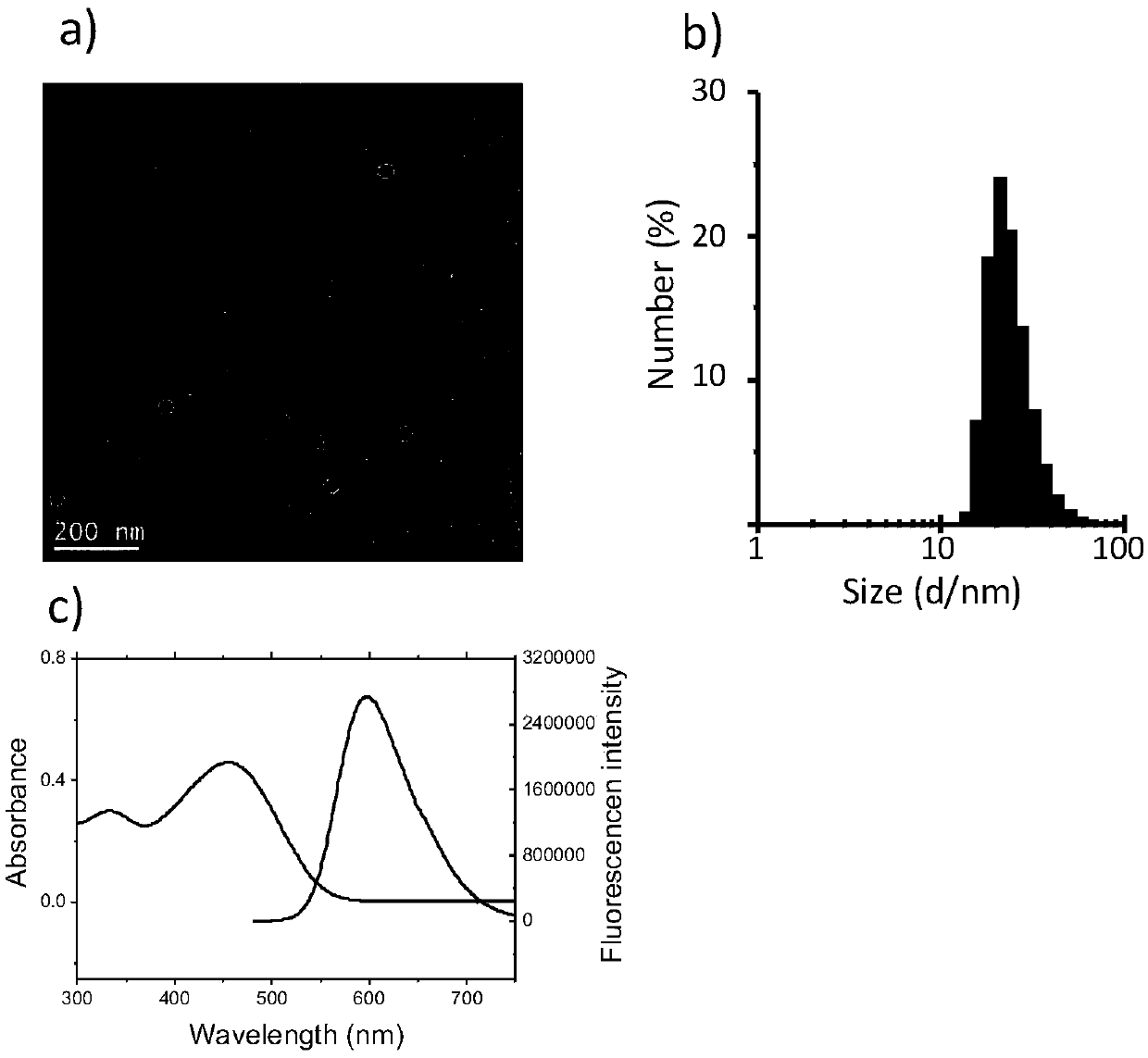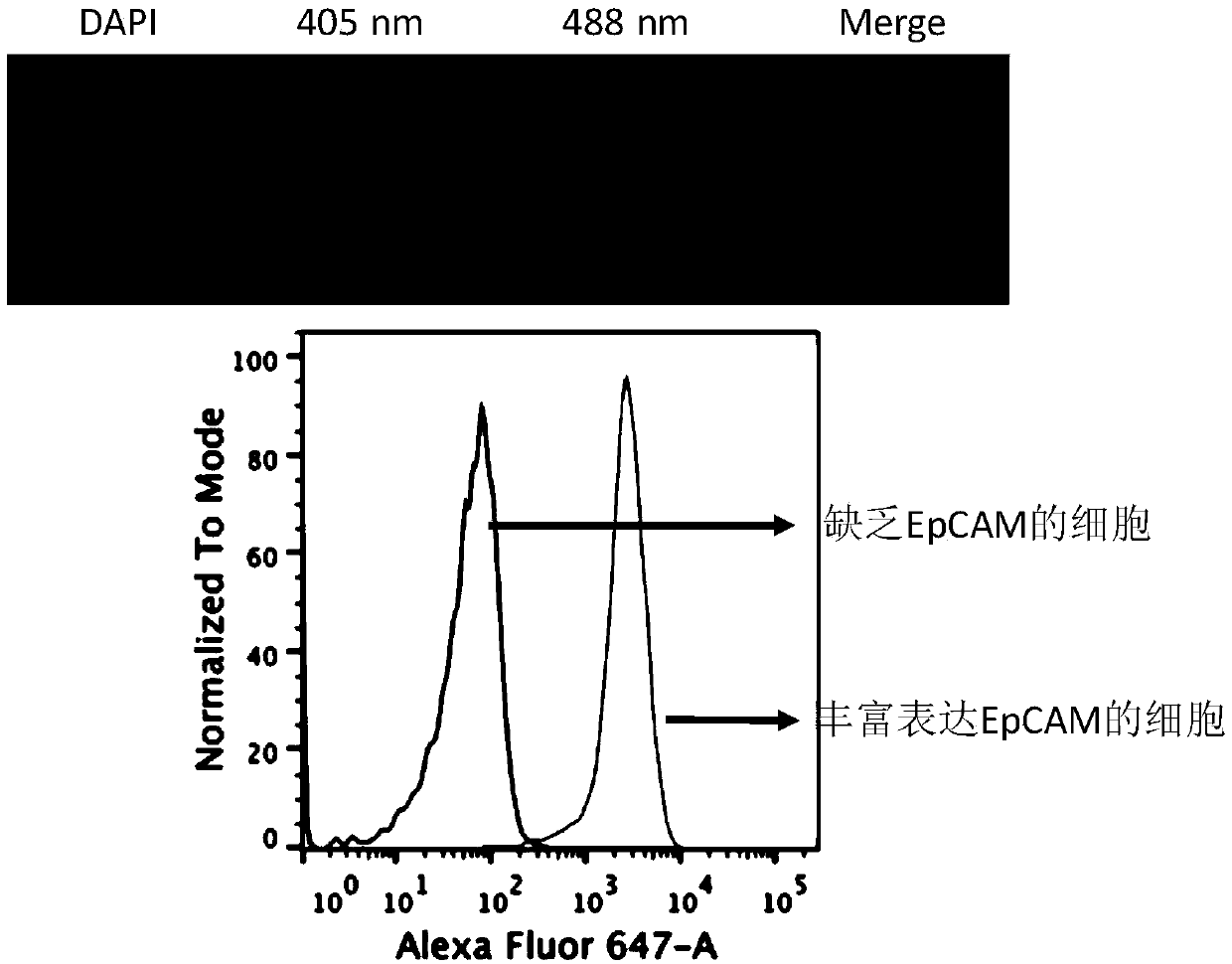Fluorescence-magnetic resonance bimodal quantum dot and preparation and application method thereof
A technology of magnetic resonance and quantum dots, applied in the field of fluorescence-magnetic resonance dual-mode quantum dots and its preparation and application, can solve the problems of low selectivity of fluorine monomer, poor stability, low fluorine content, etc., and achieve an improvement Sensitivity and specificity, good hydrophilicity, small effect size
- Summary
- Abstract
- Description
- Claims
- Application Information
AI Technical Summary
Problems solved by technology
Method used
Image
Examples
Embodiment 1
[0048] Embodiment 1: Pdots-19F particle preparation:
[0049] This embodiment takes CNPPV, PFCE, PS-PEG-COOH and THF as examples for preparation, but the protection scope of the present invention is not limited to these selected raw materials.
[0050] Both fluorocarbons and conjugated polymers of the present invention are available from Sigma Aldrich, https: / / www.sigmaaldrich.com / united-states.html.
[0051] Specifically include the following steps:
[0052] (1) conjugated polymer and fluorocarbon are dissolved in tetrahydrofuran;
[0053] (2) Rapidly inject the solution into water in an ultrasonic water bath, and keep it in the ultrasonic water bath for at least 1 min;
[0054] (3) The tetrahydrofuran is removed after the obtained solution is heated below 100° C., that is, the conjugated polymer quantum dots wrapped with fluorocarbons are obtained.
[0055] Each raw material and its addition ratio and concentration are as follows:
[0056]
[0057] Mix CNPPV, PFCE, PS...
Embodiment 2
[0059] Embodiment 2: Pdots-19F particle surface modification:
[0060] The Pdots-19F prepared in Example 1 was cross-linked by EDC to obtain targeted Pdots-19F-biophilin nanoparticles (Pdots-19F-SA).
[0061] 1.4mL, 50ppm Pdots-19F nanoparticles were placed in a 20mL glass bottle;
[0062] 2. Add 80 μL 1M HEPES and 80 μL 5% PEG solution, and keep stirring for 5 minutes;
[0063] 3. Add 40 μL of freshly prepared, 10 mg / mL EDC solution, and keep stirring for about 10 minutes;
[0064] 4. Add 240μL, 1mg / mL bioavidin solution, and keep stirring for 3 hours;
[0065] 5. Add 80 μL of 10% BSA solution and stir for 30 minutes to terminate the reaction;
[0066] 6. Put the above solution in a 4mL ultrafiltration tube (100kDa molecular weight), and centrifuge at 3500rpm for 4 minutes;
[0067] 7. Add the concentrated solution (approximately 0.5mL) from step 6 to a size chromatography column for separation. Thereby removing free small molecules and excess protein.
Embodiment 3
[0068] Example 3: Fluorescence imaging and 19FMRI imaging of Pdots-19F-SA
[0069] 1. Culture MCF-7 breast cancer cells at 37°C.
[0070] 2. Incubate biotinylated anti-EPCAM antibody (anti-epithelial cell adhesion molecule antibody) with MCF-7 cells at room temperature for 45 minutes.
[0071] 3. Wash off excess biotinylated anti-EPCAM antibody by centrifugation (1000 rpm, 5 minutes) in 1XPBS solution.
[0072] 4. Add 1-10 ppm of Pdots-19F-SA in 1X PBS and incubate at room temperature for 45 minutes.
[0073] 5. Wash off excess Pdots-19F-SA by centrifugation (1000 RPM, 5 minutes) in 1XPBS solution.
[0074] 6. Fix the cells in formalin and start fluorescence imaging, flow cytometry and 19F NMR detection, see the results image 3 and Figure 4 .
PUM
| Property | Measurement | Unit |
|---|---|---|
| particle diameter | aaaaa | aaaaa |
Abstract
Description
Claims
Application Information
 Login to View More
Login to View More - R&D
- Intellectual Property
- Life Sciences
- Materials
- Tech Scout
- Unparalleled Data Quality
- Higher Quality Content
- 60% Fewer Hallucinations
Browse by: Latest US Patents, China's latest patents, Technical Efficacy Thesaurus, Application Domain, Technology Topic, Popular Technical Reports.
© 2025 PatSnap. All rights reserved.Legal|Privacy policy|Modern Slavery Act Transparency Statement|Sitemap|About US| Contact US: help@patsnap.com



